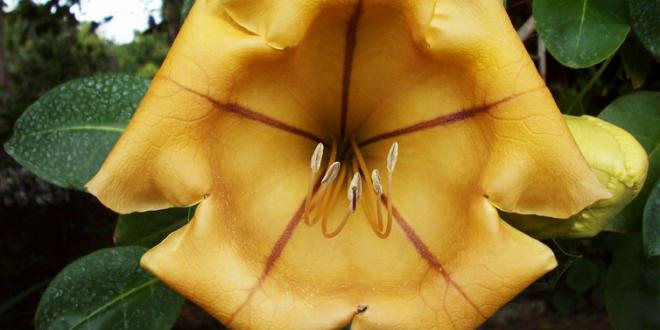This is the perfect time of the year to slow down, no, stand still and smell the stunningly beautiful buttery yellow “Cup-of-Gold-Vine”, also known as “Golden Chalice Vine”, and in Hawaii called “Hawaiian Lily”.
Its Latin name is Solandra maxima (named after the Swedish botanist Daniel C. Solander) and it belongs in the nightshade family, Solanaceae, which also tells us it has poisonous properties, like the potato vine. The Chalice vines are also related to the angel trumpets (Datura spp. and Brugmansia spp.), and just like them, are hallucinogenic. The Huichol tribes of Mexico use the Chalice Vine flowers in their sacred ceremonies.
This vigorous vine is native to the Caribbean, Mexico and Central America and typically blooms its heart out between February and April and even intermittently at other times of the year.
The reason it does so well here in our northern Baja area is that it thrives in full sun near the coast. In the hot inland valleys the roots require some sun protection. And best of all, this tropical beauty tolerates salt spray from the ocean, easily braves strong ocean winds, and fog as well.
The Solandra maxima is an ideal vine to cover a big, ugly wall, or will make a lovely welcome statement by a front door, along the eaves. These flowers are truly spectacular, shaped like a chalice, 6-10 inches long, opening up to 4-7 inches across. They start out yellow and turn deeper golden as they age. Each of the flower’s 5 lobes is marked with a narrow purplish brown ridge on the inside.
(see close-up photo).
Don’t be shy to stick your nose in and get a whiff of its subtle, slightly flirtatious perfume, especially at night, with a scent reminiscent of coconut. Beware of pollen sticking to your nose.
 Baja Review A community newspaper serving Ensenada, Valle de Guadalupe, and Rosarito in Northern Baja California
Baja Review A community newspaper serving Ensenada, Valle de Guadalupe, and Rosarito in Northern Baja California





